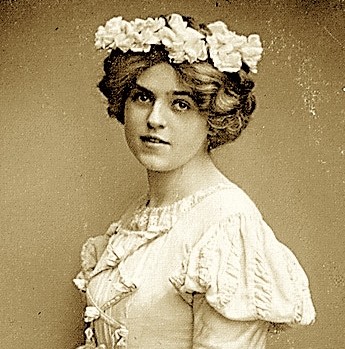
LOTTE LEHMANN was born in Perleberg, a small city not far from Berlin, in 1888. Her middle class father encouraged her in practical careers, but she was determined to study singing. After some disastrous experiences, she finally found a suitable teacher in Mathilde Mallinger, the first Eva in Wagner’s Die Meistersinger. Thereafter she landed an apprentice-level contract with the Hamburg Opera in 1910. At first clumsy and inept, she quickly moved to important roles and in 1914 sang for the first time at the Vienna Court Opera. It was also in 1914 that Lotte Lehmann made the first of her almost 500 recordings.
Lehmann began singing at the Vienna Opera full-time in 1916 and it was in Vienna that she found her true artistic home. Richard Strauss heard her sing as an understudy for the role of the Composer in his opera Ariadne auf Naxos and chose her to sing its world premiere. Thereafter she sang Strauss premieres of Intermezzo, Frau ohne Schatten as well as the Vienna premier of his Arabella and of Puccini’s Suor Angelica and Turandot. Lehmann sang an astonishing ninety-three different roles during the course of her career.
During the Vienna years Lehmann began performing Lieder (German art song). Though she claimed later that she didn’t do justice to this demanding art at this point of her development, she did record Lieder at the time. Despite the hackneyed orchestral accompaniments, Lehmann herself sounds natural and unaffected. Her recordings of Wagner’s Die Walküre and Der Rosenkavalier by Strauss were held in high esteem by critics of her day and are still regarded as classic.
In 1914 Lehmann sang for the first time in London and was, by the time of her final performance there in 1938, considered to be one of the greatest singing actresses of all time. She also appeared regularly (1926-1937) at the Salzburg festivals conducted by Krauss, Schalk, and Toscanini. Lieder recitals there paired Lehmann with “pianist” Bruno Walter.
In 1934 Lehmann made her Metropolitan Opera debut in New York City. She sang one of her favorite roles: Sieglinde in Die Walküre. The other roles she most enjoyed performing were the Marschallin, Fidelio, and Elisabeth in Tannhäuser. Problems with the Nazis had prevented her from singing for years in Germany, and just before Austria was annexed in 1938, Lehmann left Vienna. During this period, her opera career flourished at the Met and she began to sing and record more Lieder.
Throughout her life Lehmann wrote both fiction and books on her craft. In her later years she returned to writing, pedagogical as well as poetic. She also painted, did crafts and traveled the world giving master classes and giving radio and television interviews.
In 1947 Lehmann helped found the Music Academy of the West in Santa Barbara, California. She taught there from 1951 until 1962, at which point she continued to give private lessons in her Santa Barbara home almost until her death in 1976 at the age of 88.
Other Biographies
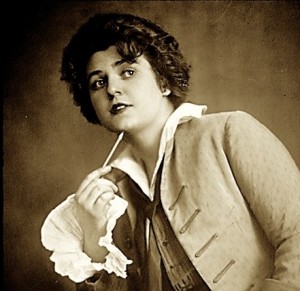
If you don’t have the Beaumont Glass and/or Micheal Kater Lehmann biographies in book form, and want a briefer summary of her life, you can choose bios written by the following people:
Medium-length from Lebendige Vergangenheit (in English)
Beaumont Glass full bio (updated book)
Bio & Drawing 1933
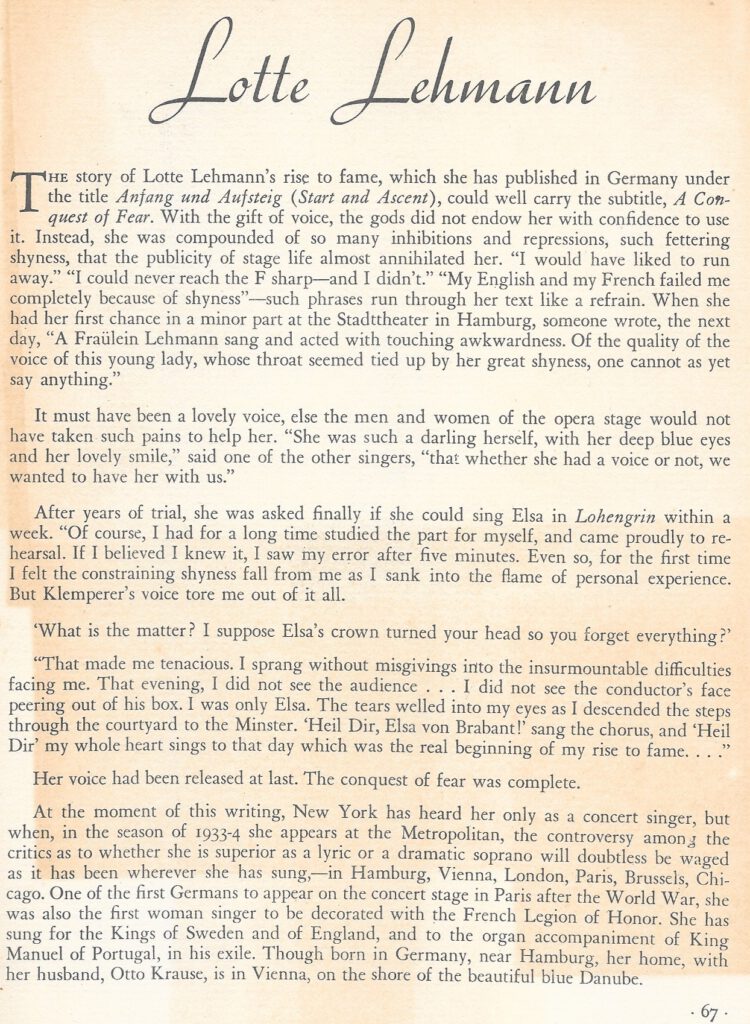
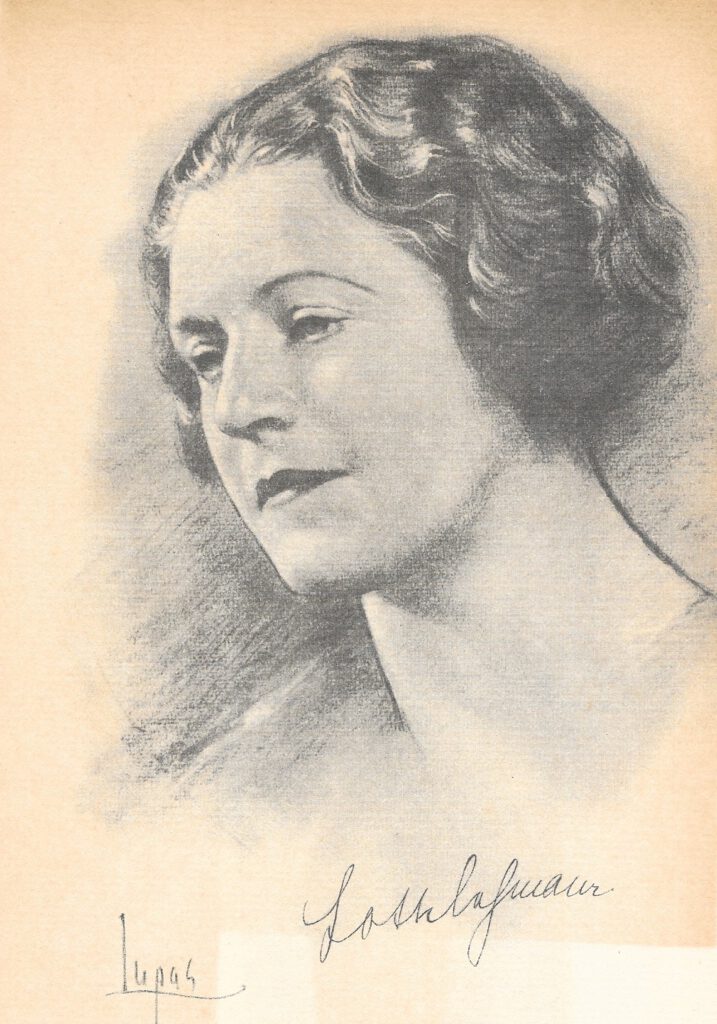
Biography in Music: Lehmann
Francis Robinson, with many connections to the Metropolitan Opera recorded a Biography in Music to celebrate Lehmann’s 80th birthday and broadcast it on 2/24/1968. Here’s background information on Mr. Robinson:
Francis Robinson began his career in the theater as an usher at the Ryman Auditorium while he was studying at Vanderbilt. He received his B.A. from Vanderbilt in 1932 and his M.A. in 1933. He went on to spend more than thirty years at the Metropolitan Opera where he served variously as tour director, assistant manager, press representative, and host of Saturday afternoon broadcasts from the Met.
Robinson began appearing on the popular “Texaco Opera Quiz” in the 1950s, which aired during radio broadcasts of Met performances, but on February 27, 1960, he came into his own on the Metropolitan Opera broadcast with a musical biography of Enrico Caruso. Using his own extensive collection of Caruso recordings and materials, Robinson put together a twenty-minute program honoring the great tenor. It was a huge success, and that broadcast was the impetus for a series by Robinson called “Biographies in Music” that took place during the third intermission of the Met’s Saturday broadcasts. In introducing Robinson and the series, Milton Cross, host of the Metropolitan Opera broadcast, said that the musical biography of Enrico Caruso was “so moving and brought so many requests for more musical biographies that we have persuaded Mr. Robinson to do a series of such broadcasts for us.” In 1978, Robinson became host for the Live from the Met telecast series, continuing to reach out to opera audiences around the country. He wrote program notes for more than 100 RCA Red Seal albums. The Francis Robinson Collection of Theatre, Music and Dance was given to the Vanderbilt Libraries in 1980.
Biographies In German
Obituaries
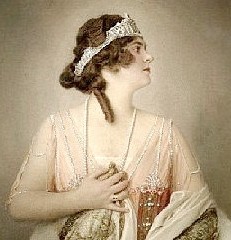
Soprano Lotte Lehmann (born on 27 February 1888, Germany; died on 26 August 1976 USA) made her operatic debut at the Hamburg Opera in 1910 and sang her last recital in August 1951. One of the greatest singers of the 20th century, creator of roles by Strauss and Korngold, Lehmann emigrated to the United States in 1937. A founder of the Music Academy of the West in Santa Barbara, California, Lehmann was also a profoundly influential teacher, a published author, poet, and painter. Her recorded legacy spans 500 releases. After retiring, she taught at her home in Santa Barbara almost until her death in 1976 at the age of 88.
New York Times Obit
Andrea Seebohm (German)
University of Portland, Oregon Alumni Newsletter
Our Vienna friend and researcher, Peter Clausen, sent a wonderful photo of the singers and the captain of the ship that took them on their South American tour in 1922. You can find Lotte Lehmann: she is marked with the number 7, standing at the top of the group, just below number 6. In case you have difficulty reading the German script: 1. Is the conductor of the German contingent, Felix Weingartner; 2. His wife; 3. The Captain; 4. Kirchhoff; 5. Schipper; 6. Braun; 7. LL; 8. Bandler; 9. Wildbrunn; 10. Dr. Kaifer; 11. Bedjtein; 12. Hirn; 13. Mertens; 14. Herr Wildbrunn (husband of the soprano Helene Wildbrunn); 15. Impresario Schraml. Following that photo are two halves of an article about the trip that Herr Clausen has written out in German. I have tried my best to translate those words.
Herr Clausen has also helped with researching two Vienna culture magazines that offered many photos of Lehmann. You can see a condensed version of what we’ve worked on.

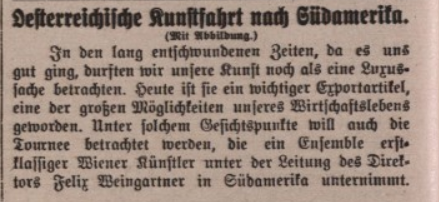
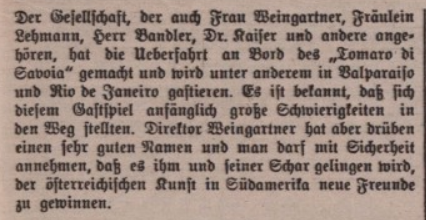
In den lang entschwundenen Zeiten, da es uns gut ging, durften wir unsere Kunst noch als eine Luxussache betrachten. Heute ist sie ein wichtiger Exportartikel, eine der groszen Moeglichkeiten unseres Wirtschaftslebens geworden. Unter solchem Gesichtspunkte will auch die Tournee betrachtet werden, die ein Ensemble erstklassiger Wiener Kuenstler unter der Leitung des Direktors Felix Weingartner in Suedamerika unternimmt.
Die Gesellschaft, der auch Frau Weingartner, Fraeulein Lehmann, Herr Bandler, Dr. Kaiser und andere angehoeren, hat die Ueberfahrt an Bord des “Tomaro di Savoia” gemacht und wird unter anderem in Valparaiso und Rio de Janeiro gastieren. Es ist bekannt, daß sich diesem Gastspiel anfaenglich große Schwierigkeiten in den Weg stellten. Direktor Weingartner hat aber drueben einen sehr guten Namen und man darf mit Sicherheit annehmen, daß es ihm und seiner Schar gelingen wird, der öesterreichischen Kunst in Suedamerika neue Freunde zu gewinnen.
In long ago times when we were doing well, we were still allowed to regard our art as a luxury thing. Today it has become an important export item, one of the great opportunities in our economic life. The tour undertaken by an ensemble of first-class Viennese artists under the direction of director Felix Weingartner to South America should also be viewed from this point of view.
The company, which also includes Mrs. Weingartner, Miss Lehmann, Mr. Bandler, Dr. Kaiser and others, made the crossing on board the “Tomaro di Savoia” and will be visiting Valparaiso and Rio de Janeiro, among other places. It is known that this guest performance initially met with great difficulties. But director Weingartner has a very good reputation over there and one can assume with certainty that he and his group will succeed in making new friends for Austrian art in South America.
